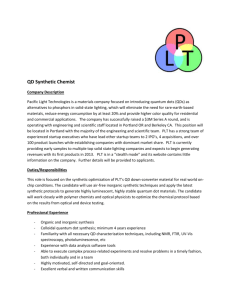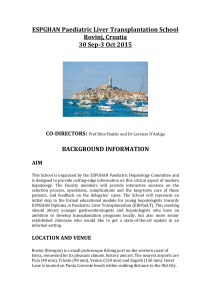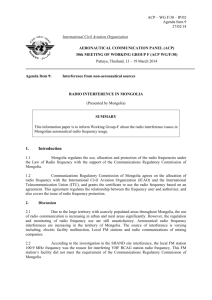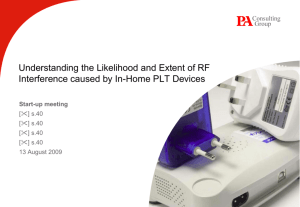POWER LINE TELECOMMUNICATION
advertisement
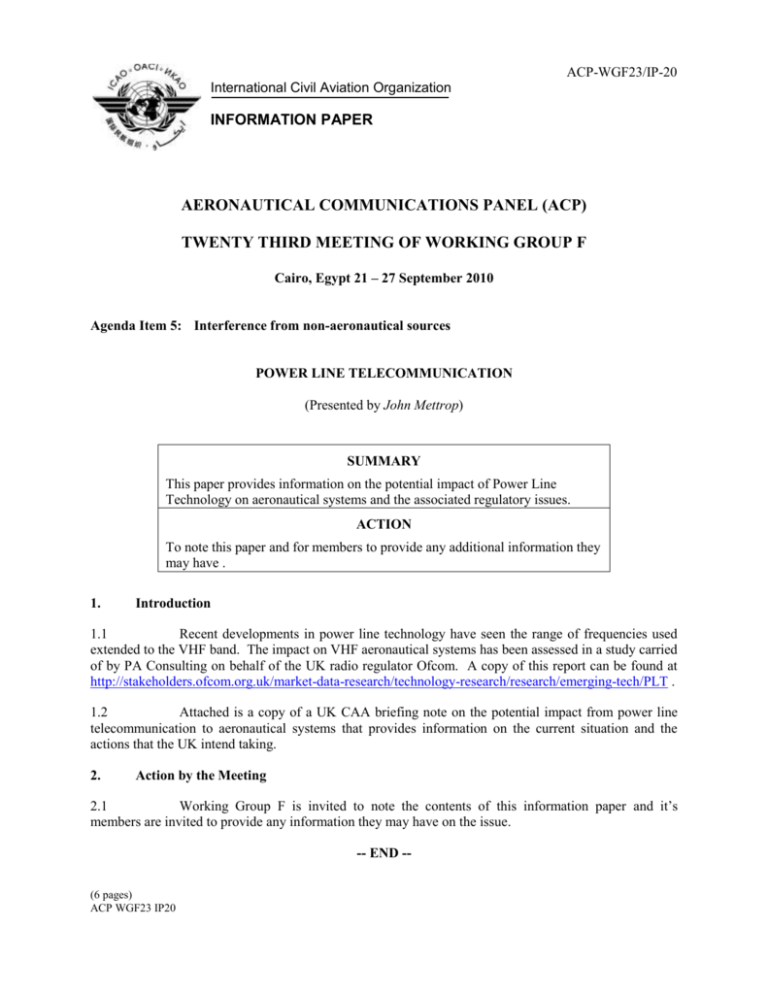
ACP-WGF23/IP-20 International Civil Aviation Organization INFORMATION PAPER AERONAUTICAL COMMUNICATIONS PANEL (ACP) TWENTY THIRD MEETING OF WORKING GROUP F Cairo, Egypt 21 – 27 September 2010 Agenda Item 5: Interference from non-aeronautical sources POWER LINE TELECOMMUNICATION (Presented by John Mettrop) SUMMARY This paper provides information on the potential impact of Power Line Technology on aeronautical systems and the associated regulatory issues. ACTION To note this paper and for members to provide any additional information they may have . 1. Introduction 1.1 Recent developments in power line technology have seen the range of frequencies used extended to the VHF band. The impact on VHF aeronautical systems has been assessed in a study carried of by PA Consulting on behalf of the UK radio regulator Ofcom. A copy of this report can be found at http://stakeholders.ofcom.org.uk/market-data-research/technology-research/research/emerging-tech/PLT . 1.2 Attached is a copy of a UK CAA briefing note on the potential impact from power line telecommunication to aeronautical systems that provides information on the current situation and the actions that the UK intend taking. 2. Action by the Meeting 2.1 Working Group F is invited to note the contents of this information paper and it’s members are invited to provide any information they may have on the issue. -- END -(6 pages) ACP WGF23 IP20 -2- ACP WGF23 IP20 Attachment 1 BRIEF ON THE POTENTIAL INTERFERENCE FROM POWER LINE TELECOMMUNICATION TO AERONAUTICAL SYSTEMS 1. summary Power Line Telecommunication (PLT) technology has been developed such that newer systems that are just being released to the market operate in the frequency range 0-320 MHz that spans the aeronautical VHF bands. This technology is aimed at provide a means of transferring data and high definition video around the home over the building’s mains wiring. Two recently carried out theoretical studies would suggest that without modifications to the current equipment specification then the probability of interference to the aeronautical systems (ILS, VOR, GBAS & VHF Comms) operating in the frequency 108-137 MHz is “High”. However the current equipment specification meets all current regulatory requirements in order to be placed on the market. Ofcom have confirmed that they believe they currently do not have sufficient enforcement powers, were interference to aeronautical systems to be reported, in order to affect an immediate closure of the interfering system. The CAA is concerned that interference originating from the legitimate operation of PLT could adversely impact aeronautical critical systems Furthermore, it appears that should this occur, it may not be possible to resolve in a timely and safe manner. Action therefore needs to be taken to ascertain whether the interference threat is real, and if that is the case, what regulatory activity is necessary to protect safety of life systems. 2. The Technology Power line telecommunication (PLT) systems operate by injecting a modulated carrier signal on the mains electricity. Since main wiring was originally designed for the transmission of AC power modulated at frequencies around 50 Hz their ability to carry higher frequencies is limited. Therefore the choice of frequency band and the potential data rate is determined by the application. Originally PLT was designed to operate below 30 MHz for the provision of internet access to the home, however this has limited market penetration in the UK. The technology was refined and the frequency range increased to 80 MHz for in-home applications such as BT Vision which to-date has over 1.5 million subscribers. In recent years however a number of companies interested in pushing the data rate boundaries even higher have developed a PLT proprietary standard that allows operation on frequencies up to 320 MHz. PLT is also being considered as a component for so called “smart grid” where a two–way communications system is overlaid onto the mains network to allow control of appliances at consumer homes and metering. It is hoped such systems will reduce energy usage, and hence costs, whilst increasing reliability and transparency. Finally PLT systems are also being considered by the automotive industry as a means of charging electric vehicles for the electricity they use as well as for the distribution of the entertainment system within the -3- ACP WGF23 IP20 car. 3. Threat PLT systems are being deployed for the provision of broadband access to homes and commercial properties, as well as within the home for sending data and high definition video without the need for additional wires. However the mains system that is being used as the transport medium has not been designed to carry these signals. There is the possibility that the mains system will radiate these signals, and hence cause interference to radio systems operating in the frequency range of the PLT signal. A theoretical study undertaken by the CAA indicating the maximum aggregated signal level of PLT at an aircraft antenna that would not cause interference has been submitted by the UK to the International Telecommunications Union Working Party 5B. This study would suggest that the emission levels from PLT could exceed this limit. These findings are supported by a report1 commissioned from PA Consulting by Ofcom that indicates the probability of interference to ILS is greater than 20% without some additional mitigation measures being applied. This probability decreases to less than 1% at the edge of the ILS coverage if mitigation of at least 30dB is applied. However in aeronautical safety terms this is still a significant percentage. These figures are based on a number of assumptions that need to be verified since a number of them are based on limited practical evidence. No practical work has yet been carried out to verify whether the theoretically predicted threat is real. 4. Potential Impact If theory is supported by practical testing then the effect on the various aeronautical systems are likely to be:ILS: Either loss of lock that would be flagged by the equipment itself or the introduction of some slight path error. VOR: Increased difficulty in detecting and resolving the signal that may increase the variation in the bearing accuracy. GBAS: Either block the differential signal or reduce the accuracy of the differential information. Both would result in reduction of the augmented GNSS positional accuracy. Comms: Either increased difficulty in resolving the message being passed or, during quiet periods, noise defeating the squelch level and being heard by either the pilot or the air traffic controller. The severity and duration of the effect will depend on a number of factors such as the location of the aircraft, the level of the radiated PLT signal and the number of PLT systems in operation within line of sight of the aircraft/VHF communications ground station. If the impact is severe enough then facilities may have to be closed. 5. Current International and Regulatory Framework Since PLT is considered an un-intentional radiator, since it is not designed to transmit a radio signal, it only has to meet the current electromagnetic compatibility regulations that specify the maximum amount of radio energy generated at a specified distance from the installation. These standards are established in Europe by CENELEC using measurement methods defined by CISPR. Within the ITU, the Telecommunications sector have written a number of Recommendations covering PLT, the latest of which ITU-R G.9960 has recently been amended to reduce the upper frequency from 200 MHz to 100 MHz. This amendment was the result of the concerns expressed by the Radiocommunications sector about potential interference. The two sectors are now working together on 1 “The Likelihood and Extent of Radio Frequency Interference from In-Home PLT Devices” http://stakeholders.ofcom.org.uk/market-data-research/technology-research/research/emerging-tech/PLT ACP WGF23 IP20 -4- further developments such as smart grid to ensure mutual compatibility. The problem with both of these regulatory frameworks is that neither is mandatory. Hence product developers who see an opportunity are looking for other standards bodies such as the IEEE in the USA to endorse their proprietary specifications as standards. These equipment’s are therefore not subject necessarily to the same level of regulation as other systems. If these manufacturers are successful other manufacturers who are currently following the ITU guidelines could choose to follow, making the situation worse. Whether a State can formally take action to shut a PLT system down when it has been identified as a source of interference will depend on that States national regulation. At least for the UK we have identified that the legal power may not be available and if this is the case in one State it may also be the case in other States and hence each State should check it’s own legislation. 6. Actions required 7. To arrange an initial practical assessment of the impact of PLT interference on aeronautical systems such as ILS as a matter of urgency. To arrange further testing, if necessary, to quantify the impact of PLT interference on aeronautical systems. To consider the various potential scenarios and the appropriate level of response. Seek a meeting with BIS and Ofcom to agree an action plan to address the following issues:o The legal powers necessary to allow Ofcom to seek immediate cessation of operation of any PLT device(s) causing interference to aeronautical systems o The legal powers needed to remove products from the market that can cause interference to aeronautical systems. o How to change international EMC regulations to ensure that equipment in the future cannot cause interference to aeronautical systems. Work with BIS and Ofcom to implement the agreed action plan. Alert our international colleagues to the potential threat Actions taken todate Submitted a document to the Spectrum Strategy Implementation Group highlighting the issue Arranged a meeting with BIS and Ofcom as well as other interested government departments to discuss the way forward Made some initial enquiries as to how practical testing could be undertaken and likely cost. Drafted a working paper for submission to the relevant ICAO, ITU and Eurocontrol groups. Worked with both the radiocommunication and telecommunication areas of the ITU to get them to improve current or write new recommendations as appropriate and send liaison statements to CISPR and CENELEC highlighting the issue. -5- ACP WGF23 IP20 ACP WGF23 IP20 -6-

